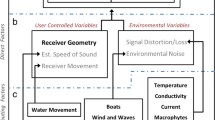Abstract
RAPT was developed to use systems of semi-autonomous buoys with hydrophones and radio transmitters to continuously monitor the positions and performance of multiple objects, animals and/or people tagged with miniature acoustic transmitters under water. Buoys communicate signal arrival times to shore, ship or aircraft based computers which triangulate positions in three dimensions and decode telemetered information such as heart rate, respiration rate, temperature, salinity and light encoded in pulse intervals. It is the only way of tracking with high-resolution (meters) at intermediate ranges (10’s–1000’s of meters) in seawater and the most accurate in freshwater. The technique is powerful and flexible with wide application, but is constrained by tradeoffs between electrical power and signal accuracy under extreme conditions. Technological solutions to some of these constraints are possible, but optimization of information gathering, in many cases, simply requires more experience and can be achieved by software, information sharing and a cadre of trained personnel.
Similar content being viewed by others
References
Augustyn, C. J., M. R. Lipinski, W. H. H. Sauer, M. J. Roberts & B. A. Mitchell-Innes, 1994. Chokka squid on the Agulhas Bank: life history and ecology. S. Afr. J. Sci. 90: 143–154.
Bégout Anras, M. L., R. A. Bodaly, P. M. Cooley, R. J. P. Fudge & K. H. Mills, 1998. Habitat utilization and swimming behaviour of lake whitefish during spawning season in a boreal lake integrating acoustic telemetry and G. I. S. this volume, in press.
Chapman, C. J., A. D. F. Johnstone & A. L. Rice, 1975. The behaviour and ecology of the Norway lobster, Nephrops noevegicus L. Proc. 9th Eur. Mar. Biol. Symp.: 59–74.
Bjordal, A, A. Engas, A. V. Soldal & J. T. Ovredal, 1993. A new radio link telemetry system: experiences from tracking fish and crustaceans. ICES cm 1993/B:23, 6 pp.
Hawkins, A. D., D. N. MacLennan, G. G. Urquhart & C. Robb, 1974. Tracking cod, Gadus morhua L., in a Scottish sea loch. J. Fish. Biol. 6: 225–236.
Lagardère, J. P., M-L. Bégout, H. Breton & J. B. C. Claret, 1995. The effects of illumination, temperature and oxygen concentration on swimming activity of turbot Psetta maxima (Linne 1758). Fish. Res. 24: 165–173.
Lagardère, J. P., J. J. Ducamp, L. Favre, J. Mosneron Dupin & M. Sperandio, 1990. A method for quantitative evaluation of fish movements in salt ponds by acoustic telemetry. J. exp. mar. Biol. Ecol. 141: 221–236.
Mather, J. & R. K. O'Dor, 1991. Foraging strategies and predation risk shape the natural history of juvenile Octopus vulgaris. Bull. Mar. Sci. 49: 256–269.
Maynard, D. R. & D. M. Webber, 1987. Monitoring the movements of snow crab (Chionoecetes opilio) with ultrasonic telemetry. Oceans '87 Proc. 3: 962–966.
McKibben, J. N. & D. R. Nelson, 1981. A portable real-time, x-y plotting system for ultrasonic tracking of fish. In F. M. Long (ed.), Proc. 3rd Int. Conf. Wildlife Telemetry: 105–115.
O'Dor, R. K., Y. Andrade, M. Roberts, W. H. H. Sauer, M. Smale & D. M. Webber, 1996. Upwelling impact on spawning behaviour of tracked Loligo vulgaris. Benguela Dynamics Symp., Cape Town.
O'Dor, R. K. & S. Seino, 1997. Monitoring marine reserves with radio-acoustic positioning and telemetry (RAPT) systems. Univ. British Columbia. Fish. Cent. Res. Rpts. 5: 14–15.
O'Dor, R. K. & D. M. Webber, 1991. Ultrasonic telemetry. The Lobster Newsletter 4: 1–2.
O'Dor, R. K., D. M. Webber, W. H. H. Sauer, M. Roberts & M. Smale, 1995. High resolution, 3D tracking of squid on spawning grounds. In C. Cristalli, C. J. Amlaner, Jr. & M. R. Neuman (eds), Proc. 13th Int. Symp. Biotelemetry, Un. Arkansas Press, Fayetteville: 193–198.
O'Dor, R. K., D. M. Webber & F. Voegeli, 1989. A multiple buoy acoustic/radio telemetry system for automated positioning and telemetry of physical and physiological data. In C. J. Amlaner (ed.), Proc. 10th Int. Symp. Biotelemetry, Un. Arkansas Press, Fayetteville: 444–452.
Sauer, W. H. H., M. J. Roberts, M. R. Lipinski, M. J. Smale, R. T. Hanlon, D. M. Webber & R. K. O'Dor, 1997. Choreography of the squid's ‘nuptial dance’. Biol. Bull. 192: 203–207.
Solomon, D. J. & E. C. E. Potter, 1988. First results with a new fish tracking system. J. Fish Biol. 33 (suppl. A): 127–132.
Wartzok, D., R. Elsner, H. Stone, B. P. Kelly & R. W. Davis, 1992b. Under-ice movements and the sensory basis of hole finding behavior in ringed and Weddell seals. Can. J. Zool. 92: 682–687.
Wartzok, D., S. Sayegh, H. Stone, J. Barchak & W. Barnes, 1992a. Acoustic tracking system for monitoring under-ice movements of polar seals. J. Acoust. Soc. Am. 92: 682–687.
Watkins, W. A. & W. E. Schevill, 1972. Sound source location with a three-dimensional hydrophone array. Deep-Sea Res. 19: 691– 706.
Rights and permissions
About this article
Cite this article
O'Dor, R.K., Andrade, Y., Webber, D.M. et al. Applications and performance of Radio-Acoustic Positioning and Telemetry (RAPT) systems. Hydrobiologia 371, 1–8 (1998). https://doi.org/10.1023/A:1017006701496
Issue Date:
DOI: https://doi.org/10.1023/A:1017006701496




